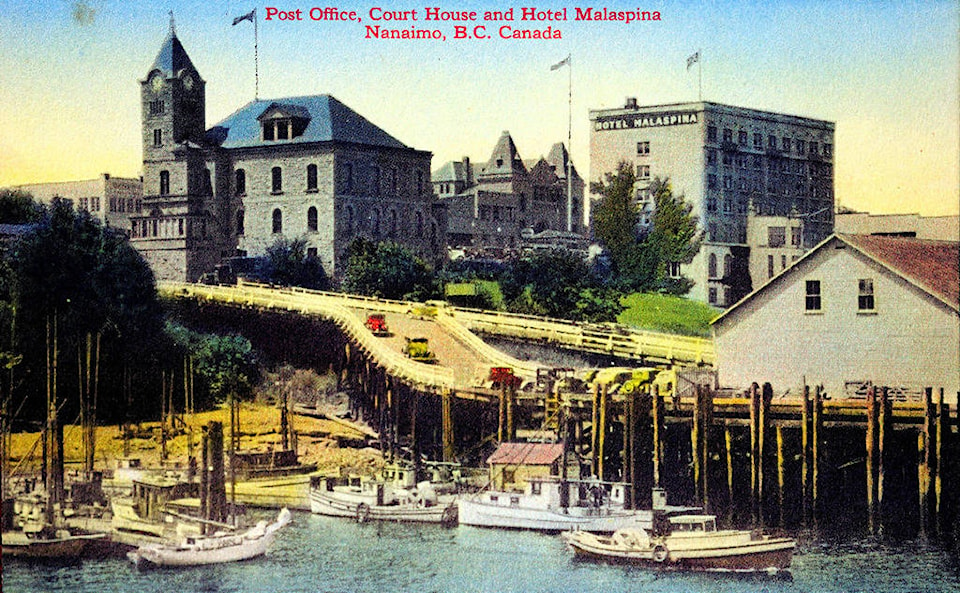During the Great Strike, it was surrounded by the militia with fixed bayonets, who also aimed a machine gun at the back door before giving the miners two minutes to clear the building in single-file.
There was a time when you couldn’t get a fair hearing in Nanaimo; at least not in a civil court. A magistrate dealt with minor criminal cases but no one could be found to discharge the duties of stipendiary magistrate.
The Hudson’s Bay Co. wouldn’t allow its employees to serve in this capacity and the few others who were qualified refused to work without pay.
Originally, there hadn’t been enough business to warrant a salary, but, with the town’s rise as a coal shipping terminal, merchants fond that, as business grew, so did their bad accounts. The lack of a local magistrate’s court put them at a distinct disadvantage when trying to exercise their rights of collection within the law.
Seventy-nine merchants and businessmen wrote His Excellency Arthur Edward Kennedy, governor of the then colony of Vancouver Island, “Sir: This humble position of the undersigned inhabitants of Nanaimo respectfully showeth — That often dishonest and fraudulent persons go away from this town leaving debts or various amounts unpaid. In consequence of there being no facilities for suing debtors for the debt here, the creditor and his business suffer.
“The only alternative for the creditor at the present time here has [been] to risk the time and money to take passage to Victoria, then attempt to sue his debtor there, who may perchance in the meantime [have] absconded. This is often the case. Your petitioners therefore humbly beg that Your Excellency will grant power to the Magistrate here to adjudicate upon all small debts by establishing a Court for that purpose.”
With a favourable response from Victoria, a Petty Debts Court was established. At first, a corner of the “Stonehouse”, an 1852 landmark at the northeast corner of Dallas Square and thought to be the Island’s first building of stone, served as unofficial court. However, Magistrate William Hayles Franklyn, a former sea captain, wasn’t impressed with having to share working quarters with the HBCo.’s accountant, and complained to both the company and the government.
It took 14 years for the construction of a real court house, which opened on Aug. 11, 1874, and served until completion of its replacement in 1896. The original, wood-framed structure, once one of the city’s largest, was purchased by Samuel Robins, superintendent of the New Vancouver Coal Co., who agreed to let the Athletic Club lease the building until they could afford to purchase it. The late Nanaimo historian John Cass recorded that the basement served as a gym where such well-known city athletes as Sinclair Swanson and his brothers, Joe Bailey, Don McLeod, Billy Townsend, and others, wrestled.
With Robins’s retirement and return to England in 1903, the members of the Athletic Club found themselves without a strong advocate and supporter. The Western Fuel Co., successors to the NVCCo., having no use for the old building, agreed to continue their lease and to allow them first option to purchase. Not until 1906 could the membership come up with the $250 down and quarterly payments plus six per cent interest on an outstanding balance of $1,000.
During the Great Strike of 1913-14, the Athletic Hall served as strike headquarters for the miners, sometimes as many as 1,200 at a meeting. Once, it was surrounded by the militia with fixed bayonets, who also aimed a machine gun at the back door before giving the miners two minutes in which to clear the building in single-file. The floorboards were then torn up in search of hidden arms but none were found and the damage was never compensated for.
With the outbreak of the First World War, many of the miners enlisted and the Athletic Club fell on hard times. It was sold back to the city in 1917 for $6,000, leased to the YMCA, then sold to a church. During the Spanish ’Flu epidemic of 1918-19, it served as an auxiliary emergency hospital before being purchased by the newly-formed Great War Veterans Association.
Because the land on which it stood wasn’t included in the deal, the historic structure had to be moved by volunteers to a new site farther up Chapel Street where, officially opened by the veterans on Nov. 18, 1924, the former Athletic Club later became Royal Canadian Legion Branch No. 10.
When they moved into the Memorial Hall on Wallace Street, Nanaimo’s first court house was left vacant for the second time in its long career. This time, there being no new lease on life, it was demolished.
T.W. will be signing his latest book, Cowichan Chronicles, Volume 5, at the Providence Farm Christmas craft show this coming Saturday, Dec. 2.
